Study 1: 1% effect in 11 cities in the U.S.
In 1972 there were a number of cities in the U.S. where 1% of the population had learned the Transcendental Meditation technique. For 11 such cities another nearby city was chosen with comparable demographic variables (geographic location, population and student population) where TM had not yet been learned by 1%. These served as the control cities. Then crime statistics were requested from the FBI and compared.
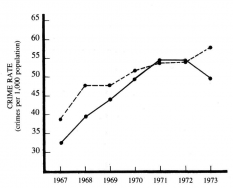 The statistics showed that in the 1% cities (full line) a significant decrease occurred in crime from 1972, both compared to earlier trends in the same city, and compared to the control cities (dotted line). There was a decrease in the number of crimes of 16.5% (p<.001). Compared to overall crime trends in the U.S. the decrease was even greater, 18%.
The statistics showed that in the 1% cities (full line) a significant decrease occurred in crime from 1972, both compared to earlier trends in the same city, and compared to the control cities (dotted line). There was a decrease in the number of crimes of 16.5% (p<.001). Compared to overall crime trends in the U.S. the decrease was even greater, 18%.
However, it turned out that this study wasn’t perfect, as a change in crime trends in the 11 cities with 1% TM practitioners could already be seen starting 1971 (crime stopped increasing in 1971 and starts decreasing from 1972).
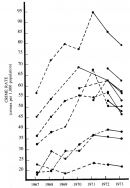 However, when you look at more detailed crime statistics for the 11 cities, you’ll find that in quite a few cities sufficient TM practitioners lived in the cities in 1971 already to make up 1% of the population (line full as soon as 1% threshold is reached). This meant that the average of the 11 cities no longer increased from 1971 to 1972. This therefore appears to be extra confirmation of the effect. As soon as the 1% threshold is reached, crime will decrease.
However, when you look at more detailed crime statistics for the 11 cities, you’ll find that in quite a few cities sufficient TM practitioners lived in the cities in 1971 already to make up 1% of the population (line full as soon as 1% threshold is reached). This meant that the average of the 11 cities no longer increased from 1971 to 1972. This therefore appears to be extra confirmation of the effect. As soon as the 1% threshold is reached, crime will decrease.
The full study is published in: Scientific Research on Maharishi’s Transcendetental Meditation Vol. 1, 98, pp 639-648
Study 7: Prospective 1% effect study in Lebanon
In order to test the kind of effect achieved through the 1% TM effect in a real war situation, a village with around 10.000 inhabitants was selected in Lebanon at the time of the civil war (1980), and it was declared up front that violence would decrease in this village, compared to other villages in the same region with the same demographic variables. Transcendental Meditation teachers started teaching the TM technique to locals in the village, without explaining the actual purpose of the study. They only spoke of personal advantages of the technique. As soon as the 1% threshold was reached, in the summer of 1982, people looked at the number of “shells” fired (grenades and mortars), the number of deaths and the number of injured over a period of 2 years. As the source for their data they took the largest, most objective newspaper in Lebanon.
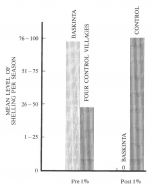
Spring had always been the time of year where most fights occurred. Prior to reaching 1%, 45 mortars were fired in the village in the spring of 1979, 50 in 1980, 1705 in 1981 and 353 in 1982. In the spring of 1983, when 1% of the village had learned TM, not a single mortar or grenade was fired (p<.00001). During the subsequent 2 years not a single death occurred in the village (Baskinta) (p<.005), not a single injury (p<.005), and not a single case of damage to housing (p<.005) as a result of war violence. In the 4 control cities, less than 20 km away from this village, violence increased in the 2 years after the summer of 1982, in comparison to the previous 4 years.Ref.Scientific Research on Maharishi’s Transcendental Meditation, Collected Papers vol. 4, No. 331 pp. 2623-2633
Study 9: Decreased war intensity in 5 areas around the world through Yogic Flying
1400 volunteers trained in the TM sidhi programme and in Yogic Flying offered to participate in a global experiment, the “World Peace Project” that took place from early October to late December 1978. The TM organisation financed the entire project from its own funds and donor funds. The Yogic Flyers traveled to different problem areas around the world where war already existed, or where the situation was dangerously explosive. They stayed in the relevant areas or, where this was not possible for reasons of security, as close to the areas as possible:
Lebanon: (civil war) 100 Yogic Flyers in Cyprus and Syria, 400 Yogic Flyers in a TM sidhi course in Israel close to the Lebanese border
Iran: (explosive situation immediately before the coming to power of Ayatollah Komeini) 206 Yogic Flyers
Thailand: (fear for spreading of war from Cambodia to Thailand): 260 Yogic Flyers
Nicaragua: (civil war, 1200 deaths in September ’78) 140 Yogic Flyers to Nicaragua, and 160 to surrounding countries Honduras, Costa Rica, Guatemala and El Salvador.
Zimbabwe (then Rhodesia, civil war, 1000 deaths in September ’78): 121 Yogic Flyers
The description of the effects of this experiment is full of miraculous events, like how there were daily bombings in Zimbabwe, but from the day the Yogic Flyers arrived the situation calmed, and in the entire country the number of deaths a day dropped by 80%, from 16 to 3, and how the government requested the Yogic Flyers to extend their stay as, whatever it was they were doing, it worked, and how the day after they finally left a bomb attack occurred and the level of violence returned to the level it was at prior to the experiment.
However, to shed these events in a more objective light, researchers worked closely with the Conflict and Peace Data Bank (COPDAB), then the world’s largest database around news events. They collected news from all over the world, national and international media (415.000 events over the previous 30 years) and would score these depending on whether it was positive or negative news, divided into 3 large groups:
- Cooperative Events: events of cooperation, peace
- Verbal hostilities: mild and strongly hostile remarks about the opponent
- Hostile acts: Hostile deeds, from removal of ambassadors to war
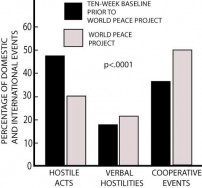 These numbers showed that, during the 10 weeks of the World Peace Project in comparison to the previous 10 weeks, the number of “hostile acts” across the 5 areas dropped by 30%, while the number of “cooperative events” increased by 30% (p<.0001). Later analysis showed that this had nothing to do with the time of year. During the previous time years no differences were noticeable in the same period.Ref.Scientific Research on Maharishi’s Transcendental Meditation, Collected Papers vol. 4 no. 322 pp. 2532-2548
These numbers showed that, during the 10 weeks of the World Peace Project in comparison to the previous 10 weeks, the number of “hostile acts” across the 5 areas dropped by 30%, while the number of “cooperative events” increased by 30% (p<.0001). Later analysis showed that this had nothing to do with the time of year. During the previous time years no differences were noticeable in the same period.Ref.Scientific Research on Maharishi’s Transcendental Meditation, Collected Papers vol. 4 no. 322 pp. 2532-2548Study 17: Decrease in crime in Puerto Rico due to Yogic Flying
In 1984 there was an opportunity for an experiment in Puerto Rico. 185 Yogic Flyers, enough to create an influence for all 3.4 million inhabitants of Puerto Rico, were trained at a local Transcendental Meditation academy, and continued to practice their TM, TM sidhi programme and Yogic Flying together from April to July 1984, although in May they only had 80% of the minimum number, and in June 60%. An analysis of crime statistics nevertheless showed a significant decrease in crime numbers for the entire country, starting in April (p<.025), and an increase again starting July (p<.025).Ref.The Journal of Mind and Behavior 8: 67–104, 1987Ref.Scientific Research on Maharishi’s Transcendental Meditation, Collected Papers Vol. 4, no. 334, pp. 2679-2687
Study 18: Improved quality of life in Israel and reduced violence in Lebanon
Of all the studies on the Maharishi effect, this might be the most impressive one. This study was possible thanks to the generous contribution of William Ellinghaus, at the time general director of the telecom giant AT&T.
A group of scientists organised a prospective study during the summer of 1983 in Jerusalem. According to the formula, square root of 1% of the population, 65 Yogic Flyers would be required to create an influence for Jerusalem, 121 for all of Israel, and 192 for Israel and Lebanon together.
Predictions were recorded by an independent group of scientists: If the group of Yogic Flyers was big enough, the following measurable effects would occur:
In Jerusalem
1. Crime: Decrease in the total number of crimes per day. Source: Social Department Research of the Israeli police.
2. Car accidents: Decrease in the total number a day with personal injuries. Source: municipal authorities of Jerusalem
3. Fires: Decrease in the total number of incidents to which the fire services had to respond during the day. Source: municipal authorities of Jerusalem
In Israel
4. Crime: Decrease in the number of crimes per day (with the exception of Jerusalem), Source: Israeli police
5. Financial markets: Increase for Tel Aviv Stock Exchange shares
6. National mood: Better affective tone of the most prominent story (picture story on the front page) of the Jerusalem Post, according to an independent score of 1 (very negative, unpleasant) to 7 (very positive, optimistic). Scores were blind and used the average scores of two different judges independent from the project (Israeli students)
Lebanon
7. War victims: Decrease in the number of military and civil victims as a result of the Lebanon conflict, as reported in the major daily Israeli newspapers, the International Herald Tribune and the BBC World Service.
8. War intensity: Improvement in the scale of the intensity in the hostilities in Lebanon every day, as reported in news stories in the Jerusalem Post. The 5 point scale varied from 0 (no reports of fights) to 4 (full war). The rating was blind in relation to data and incidents and the analysis used the average of three independent judges that were unaware of the purpose of the experiment.
The purpose of the experiment was to create a constant group of 200 participants over a period of the two months of the experiment from 1 August to 30 September 1981, but because the group of Yogic Flyers consisted entirely of volunteers, this was practically impossible. Some could only stay for a few weeks before they returned to work or study. As a result, the number of Yogic Flyers fluctuated over the 8 weeks of the study. Here is a graph of the number of Yogic Flyers (MTUF stands for the Maharishi Technology of the Unified Field).
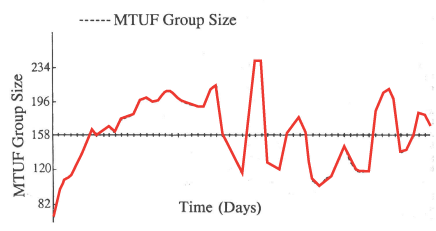
However, the fluctuations didn’t prove to be too much of a challenge for the researchers. Considering the daily data available to them on all 8 variables, they were also able to create a daily graph of how these fluctuated, and consider whether they were able to make a statistical correlation between the number of Yogic Flyers and the 8 variables under scrutiny. All eight were brought together into one index in line with acceptable statistical methods, and the index was then plotted over the 60 days of the study. When the scientists saw the study they almost fell off their chairs. No statistic was required at all to calculate the correlation, the overlap was so clear that anyone could see it with their own eyes (r = -.57 p<.0001).
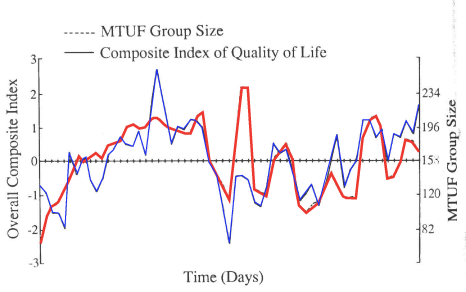
Normally, if one were to plot the fluctuations of 8 different, uncorrelated variables, the graph should look quite flat, as random fluctuations normally cancel. Not a single investor with a sound mind would base his purchase decision on the number of fires in Jerusalem. If these 8 could fluctuate so strongly (fluctuations of -3 to +3 standard deviations are very exceptional, in particular if there are 8 independent variables simultaneously) then there had to be something influencing all 8 together.
It is like someone turning the knob on a light dimmer and witnessing, full of surprise, the light increase and decrease. Instead of the light, we were witnessing the quality of the unified field at the source of everyone’s thoughts in Israel and Lebanon (see qualities unified field), that ultimately all came down to unity and positivity. That same source created more optimism among investors on the stock exchange, a stronger feeling of connectedness with fellow human beings on the war fields in Lebanon, causing a reduction in violence and fewer war victims (from an average of 24.5 deaths a day to 1.5 on days where there were enough flyers to influence Lebanon). That same source also created more optimism in newspapers, and more harmony and order in society, causing less accidents.
This study was so impressive, especially because the data all came from fully objective sources, that it resulted in one of the most prestigious publications to date, in the Journal of Conflict Resolution, vol. 32, no.4, Dec 1988, pp. 776-812. The process to get published nevertheless took 2 years, and the editor of the journal wrote the following note:
“The following article presents and tests a hypothesis that will strike most readers (myself included) as, to say the least, unorthodox…Yet the hypothesis seems logically derived from the initial premises, and its empirical testing seems competently executed. These are the standards to which manuscripts submitted for publication in this journal are normally submitted.”
Study 18: Decrease in crime and deaths in Manila, Philippines
In December 1979 a business man in Manila decided to create a group of Yogic Flyers among the employees of his company. As part of their working hours, employees could practice TM, the TM sidhi programme and Yogic Flying in the morning and evening. It was then decided to organise a new experiment, with predictions up front that crime and deaths would decrease significantly both in Manila and the Philippines as a whole. The number of Yogic Flyers taking part in the experiment was 400, which was more than what was required for Manila alone (300) but less than required for all of the Philippines (750). It was therefore decided to make an index with numbers for both.
What was interesting about this experiment was that the group was formed spontaneously in December 1979, but that, due to circumstances, several employees had to leave the location, causing the group to shrink over the following 2 years, until only about half remained at the end of the study in December 1981. When the numbers of the Index were studied, a significant decrease in the number of crimes and deaths showed in December 1979 (p<.025), followed by a gradual increase until December 1981, which seemed to quite precisely follow the number of Yogic Flyers (p<.001).Ref.The Journal of Mind and Behavior 8: 67–104, 1987,Scientific Research on Maharishi’s Transcendental Meditation, Collected Papers vol. 5, no. 401, pp. 3151-3171
Social effects of Yogic Flying studied.
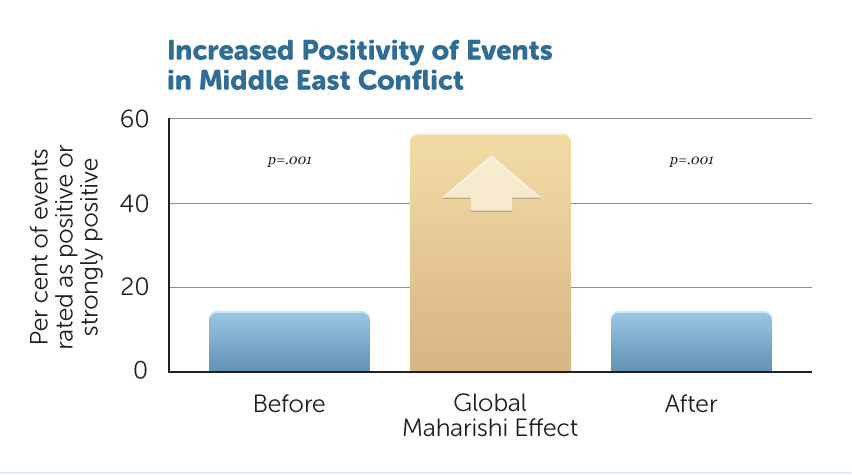 During the three-week period of the Taste of Utopia Assembly, compared to the three weeks before, there was a significant increase in positive events associated with the Middle East conflict in Lebanon, as principally seen in the rapid evolution of an agreement on a national security plan. In the three weeks after the Assembly the situation quickly deteriorated. Control data from the previous year showed that the specific time of year of the assembly was not associated with improved conditions in this conflict.Ref.Scientific Research on Maharishi’s Transcendental Meditation and TM-Sidhi Programme: Collected Papers (Vol. 4, 1989, pp. 2730–2762)
During the three-week period of the Taste of Utopia Assembly, compared to the three weeks before, there was a significant increase in positive events associated with the Middle East conflict in Lebanon, as principally seen in the rapid evolution of an agreement on a national security plan. In the three weeks after the Assembly the situation quickly deteriorated. Control data from the previous year showed that the specific time of year of the assembly was not associated with improved conditions in this conflict.Ref.Scientific Research on Maharishi’s Transcendental Meditation and TM-Sidhi Programme: Collected Papers (Vol. 4, 1989, pp. 2730–2762)
Social effects of Yogic Flying studied.
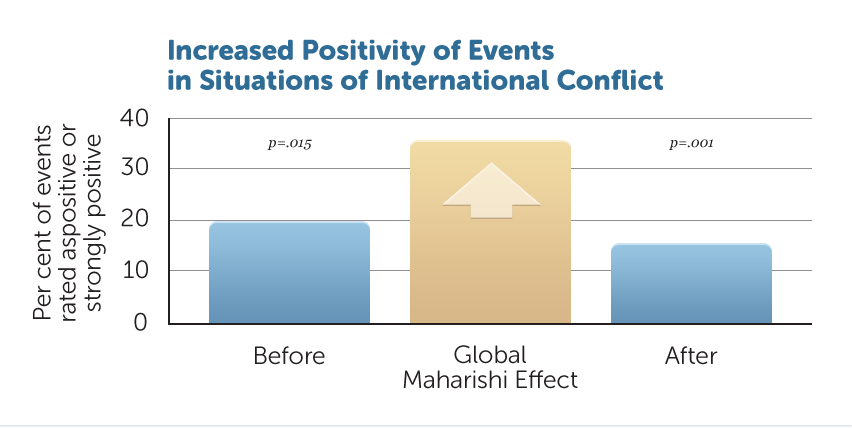 During the three-week period of the Taste of Utopia Assembly, compared to the three-week period before the Assembly, the balance of negativity to positivity in events pertaining to international conflicts in the trouble-spot areas of the world shifted significantly towards increased positivity, as indicated by content analysis of the news. In the three-week period after the assembly the balance of events reverted towards the previous condition of increased negativity. Such trends were not found during the same time the previous year.Ref.Scientific Research on Maharishi’s Transcendental Meditation and TM-Sidhi Programme: Collected Papers (Vol. 4, 1989, pp. 2730–2762)
During the three-week period of the Taste of Utopia Assembly, compared to the three-week period before the Assembly, the balance of negativity to positivity in events pertaining to international conflicts in the trouble-spot areas of the world shifted significantly towards increased positivity, as indicated by content analysis of the news. In the three-week period after the assembly the balance of events reverted towards the previous condition of increased negativity. Such trends were not found during the same time the previous year.Ref.Scientific Research on Maharishi’s Transcendental Meditation and TM-Sidhi Programme: Collected Papers (Vol. 4, 1989, pp. 2730–2762)
Social effects of Yogic Flying studied.
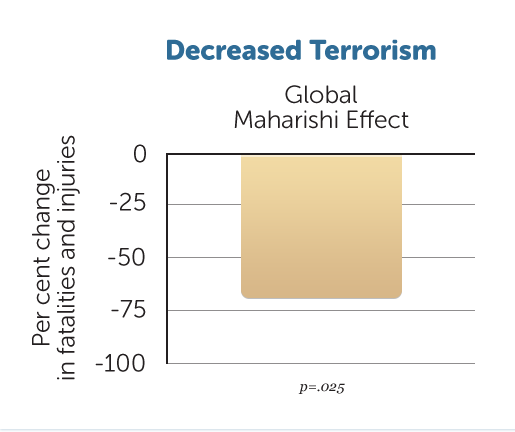 There was a significant decrease in fatalities and injuries due to international terrorism during the periods of three assemblies approaching or exceeding 7,000 experts in the TM Sidhi Programme (the square root of one per cent of the world’s population at the time), as indicated by time series analysis of an independent data bank.Ref.Journal of Offender Rehabilitation 36: 283–302, 2003
There was a significant decrease in fatalities and injuries due to international terrorism during the periods of three assemblies approaching or exceeding 7,000 experts in the TM Sidhi Programme (the square root of one per cent of the world’s population at the time), as indicated by time series analysis of an independent data bank.Ref.Journal of Offender Rehabilitation 36: 283–302, 2003
Social effects of Yogic Flying studied.
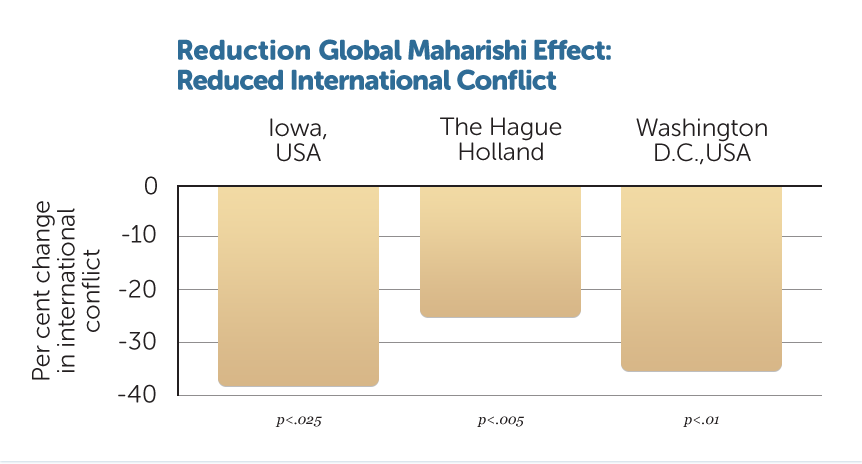 During the periods of three assemblies approaching or exceeding 7,000 experts in the TM Sidhi Programme (the square root of one per cent of the world’s population at the time), there was a significant decrease in international conflict worldwide.Ref.Journal of Offender Rehabilitation 36: 283–302, 200
During the periods of three assemblies approaching or exceeding 7,000 experts in the TM Sidhi Programme (the square root of one per cent of the world’s population at the time), there was a significant decrease in international conflict worldwide.Ref.Journal of Offender Rehabilitation 36: 283–302, 200
Social effects of Yogic Flying studied.
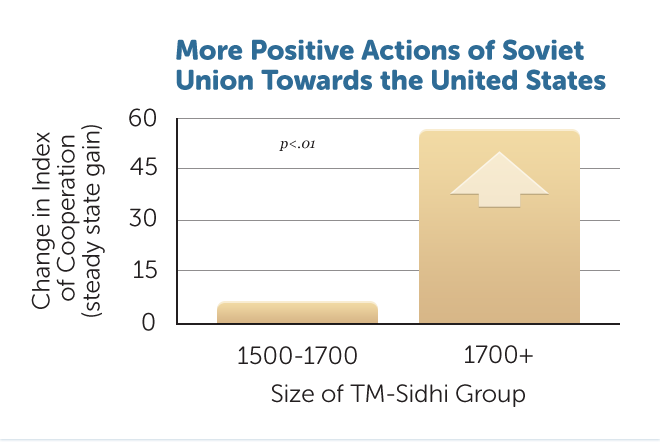 During periods from 1979 to 1986 when the size of a group of participants in the TM Sidhi Programme in the United States was larger than 1700, creating the strongest influence of the Maharishi Effect in the United States, there was a significant increase of positivity of actions of the Soviet Union towards the United States. This result, found by time series analysis of an independent data bank, was independent of the effect of US actions towards the Soviet Union.Ref.Proceedings of the American Statistical Association, Social Statistics Section, pp. 297–302. Alexandria, VA: American Statistical Association, 1990
During periods from 1979 to 1986 when the size of a group of participants in the TM Sidhi Programme in the United States was larger than 1700, creating the strongest influence of the Maharishi Effect in the United States, there was a significant increase of positivity of actions of the Soviet Union towards the United States. This result, found by time series analysis of an independent data bank, was independent of the effect of US actions towards the Soviet Union.Ref.Proceedings of the American Statistical Association, Social Statistics Section, pp. 297–302. Alexandria, VA: American Statistical Association, 1990
Social effects of Yogic Flying studied.
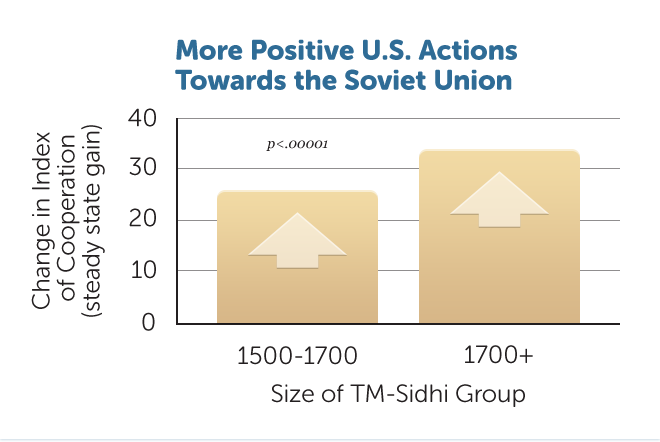 As indicated by time series analysis of an independent data bank, during periods from 1979 to 1986 when the size of a group of participants in the TM Sidhi Programme in the United States was larger than the square root of one per cent of the US population (over 1500 at the time), there was a significant increase in the positivity of actions of the United States towards the Soviet Union, compared to periods when the size of the group was smaller (below 1500).Ref.Proceedings of the American Statistical Association, Social Statistics Section, pp. 297–302. Alexandria, VA: American Statistical
As indicated by time series analysis of an independent data bank, during periods from 1979 to 1986 when the size of a group of participants in the TM Sidhi Programme in the United States was larger than the square root of one per cent of the US population (over 1500 at the time), there was a significant increase in the positivity of actions of the United States towards the Soviet Union, compared to periods when the size of the group was smaller (below 1500).Ref.Proceedings of the American Statistical Association, Social Statistics Section, pp. 297–302. Alexandria, VA: American Statistical
Social effects of Yogic Flying studied.
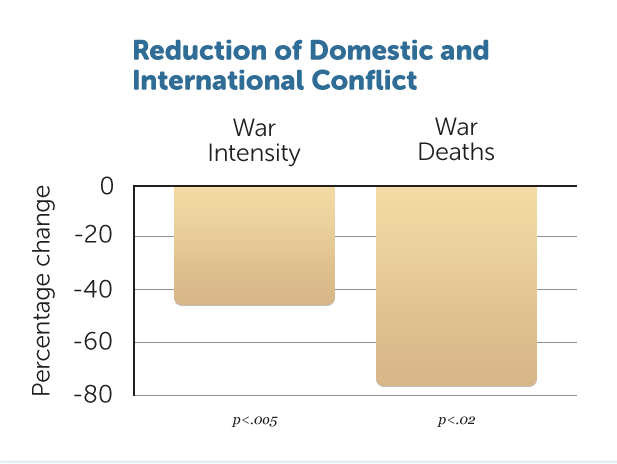 During periods when a large group was participating in the TM Sidhi Programme, there was a significant drop in war intensity and war deaths in the neighbouring Middle East conflict.Ref.Journal of Conflict Resolution 32: 776–812, 1988
During periods when a large group was participating in the TM Sidhi Programme, there was a significant drop in war intensity and war deaths in the neighbouring Middle East conflict.Ref.Journal of Conflict Resolution 32: 776–812, 1988
Social effects of Yogic Flying studied.
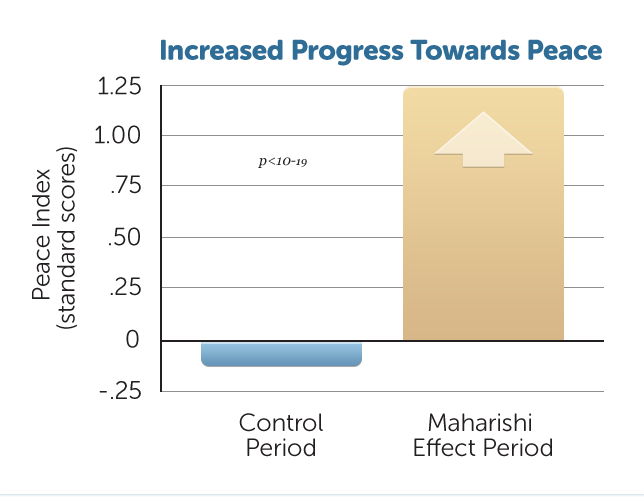 During periods in 1983–1985 when sufficiently large groups of participants in the TM Sidhi Programme were established, there was a significant increase in progress towards peace in the Middle East, as measured by an index comprising increased cooperation, reduced level of conflict, reduced war fatalities, and reduced war injuries.Ref.Journal of Social Behavior and Personality 17: 285–338, 2005
During periods in 1983–1985 when sufficiently large groups of participants in the TM Sidhi Programme were established, there was a significant increase in progress towards peace in the Middle East, as measured by an index comprising increased cooperation, reduced level of conflict, reduced war fatalities, and reduced war injuries.Ref.Journal of Social Behavior and Personality 17: 285–338, 2005
Social effects of Yogic Flying studied.
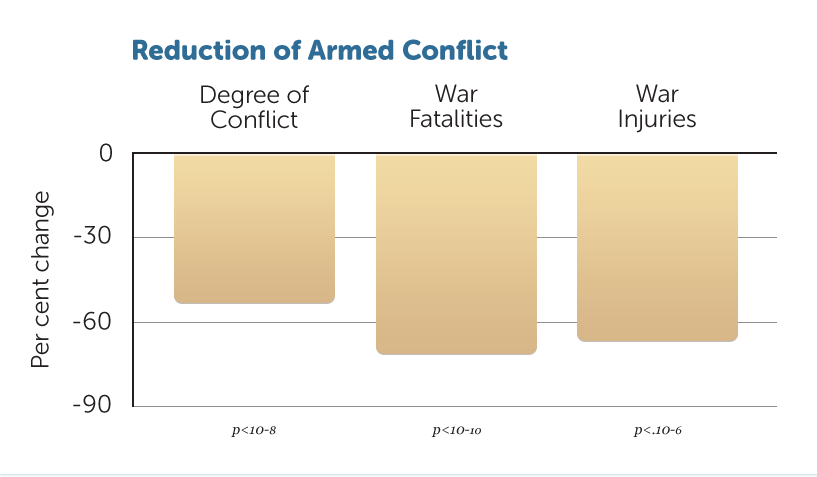 There was a significant decrease in degree of conflict, war fatalities, and war injuries in the Middle East during periods in 1983–1985 when sufficiently large groups of participants in the TM Sidhi Programme were established.Ref.Journal of Social Behavior and Personality 17: 285–338, 2005
There was a significant decrease in degree of conflict, war fatalities, and war injuries in the Middle East during periods in 1983–1985 when sufficiently large groups of participants in the TM Sidhi Programme were established.Ref.Journal of Social Behavior and Personality 17: 285–338, 2005
Social effects of Yogic Flying studied.
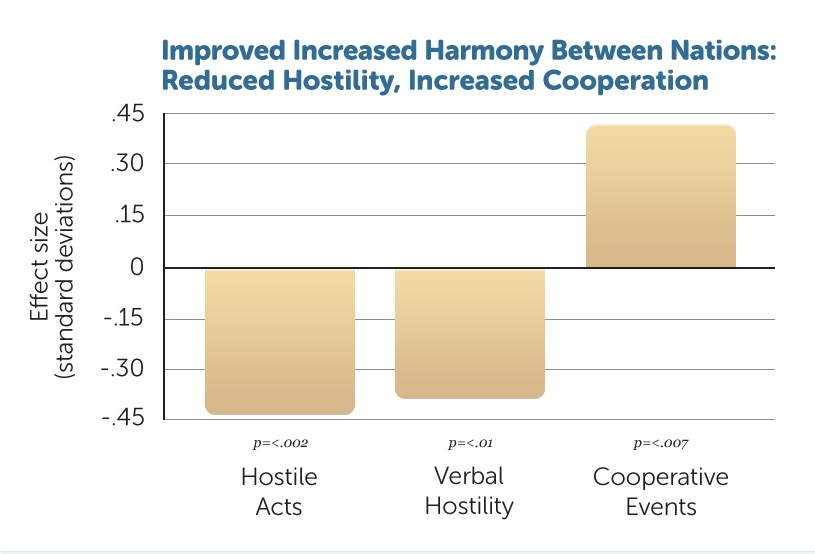 During Maharishi’s World Peace Project of October–December 1978, groups of experts in Maharishi’s TM-Sidhi Yogic Flying Programme went to the world’s regional trouble spots in Southeast Asia, the Middle East, southern Africa and Central America. Time series analysis of data from an independent data bank showed that during the peace project there was a significant worldwide decrease in international hostile acts and verbal hostility, and an increase in cooperative events; this global effect was due to the fact that the primary international conflict areas were being influenced locally by the groups of experts in the TM-Sidhi Programme.Ref.Scientific Research on Maharishi’s Transcendental Meditation and TM-Sidhi Programme: Collected Papers, Vol. 4: 2532–2548, 1989
During Maharishi’s World Peace Project of October–December 1978, groups of experts in Maharishi’s TM-Sidhi Yogic Flying Programme went to the world’s regional trouble spots in Southeast Asia, the Middle East, southern Africa and Central America. Time series analysis of data from an independent data bank showed that during the peace project there was a significant worldwide decrease in international hostile acts and verbal hostility, and an increase in cooperative events; this global effect was due to the fact that the primary international conflict areas were being influenced locally by the groups of experts in the TM-Sidhi Programme.Ref.Scientific Research on Maharishi’s Transcendental Meditation and TM-Sidhi Programme: Collected Papers, Vol. 4: 2532–2548, 1989
Social effects of Yogic Flying studied.
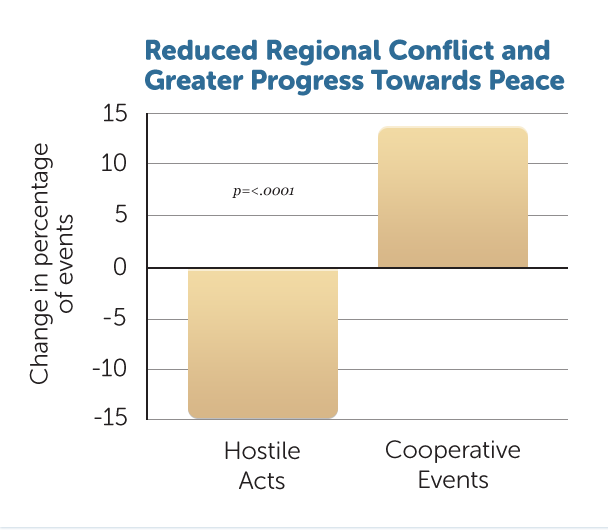 During Maharishi’s World Peace Project of October–December 1978, experts in Maharishi’s TM-Sidhi Programme went to the world’s regional trouble spots in Southeast Asia, the Middle East, southern Africa and Central America to create a calming influence through the group practice of Yogic Flying. During this time period, in comparison to a baseline period prior to the project, analysis of data from an independent data bank showed reduced hostile acts and increased cooperative events in those areas and among nations involved in these conflicts.Ref.Scientific Research on Maharishi’s Transcendental Meditation and TM-Sidhi Programme: Collected Papers, Vol. 4: 2532–2548, 1989
During Maharishi’s World Peace Project of October–December 1978, experts in Maharishi’s TM-Sidhi Programme went to the world’s regional trouble spots in Southeast Asia, the Middle East, southern Africa and Central America to create a calming influence through the group practice of Yogic Flying. During this time period, in comparison to a baseline period prior to the project, analysis of data from an independent data bank showed reduced hostile acts and increased cooperative events in those areas and among nations involved in these conflicts.Ref.Scientific Research on Maharishi’s Transcendental Meditation and TM-Sidhi Programme: Collected Papers, Vol. 4: 2532–2548, 1989
Social effects of Yogic Flying studied.
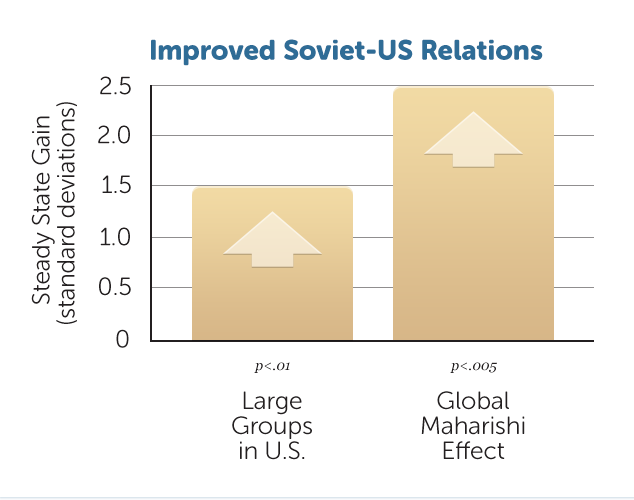 During periods from 1979 to 1986 the size of a group of participants in the TM Sidhi Programme in the United States was larger than 1700, creating the strongest influence of the Maharishi Effect in the United States. There was a significant increase of positivity of actions of the Soviet Union towards the United States, as shown by the left bar. The right bar indicates an even greater increase in positive actions of the Soviet Union towards the United States, during the specific periods of several assemblies in North America and in Europe that approached or exceeded the square root of one per cent of the world’s population, about 7,000 at the time. The study, using time series analysis of an independent data bank, the Zürich Project on East-West Relations, confirmed that this influence of increased positivity was independent of the actions of the US towards the Soviet Union and independent of changes in Soviet leadership. In addition, during periods when the size of the group in the United States was sufficient to create the Maharishi Effect in the US, the behaviour of the United States towards the Soviet Union also became more positive.Ref.Proceedings of the American Statistical Association, Social Statistics Section, pp. 297–302. Alexandria, VA: American Statistical Association, 1990. (2) ‘U.S.–Soviet relations and the Maharishi Effect: A time series analysis.’ Paper presented at the Annual Meeting of the American Statistical Association, Social Statistics Section, Atlanta, Georgia, August 1991
During periods from 1979 to 1986 the size of a group of participants in the TM Sidhi Programme in the United States was larger than 1700, creating the strongest influence of the Maharishi Effect in the United States. There was a significant increase of positivity of actions of the Soviet Union towards the United States, as shown by the left bar. The right bar indicates an even greater increase in positive actions of the Soviet Union towards the United States, during the specific periods of several assemblies in North America and in Europe that approached or exceeded the square root of one per cent of the world’s population, about 7,000 at the time. The study, using time series analysis of an independent data bank, the Zürich Project on East-West Relations, confirmed that this influence of increased positivity was independent of the actions of the US towards the Soviet Union and independent of changes in Soviet leadership. In addition, during periods when the size of the group in the United States was sufficient to create the Maharishi Effect in the US, the behaviour of the United States towards the Soviet Union also became more positive.Ref.Proceedings of the American Statistical Association, Social Statistics Section, pp. 297–302. Alexandria, VA: American Statistical Association, 1990. (2) ‘U.S.–Soviet relations and the Maharishi Effect: A time series analysis.’ Paper presented at the Annual Meeting of the American Statistical Association, Social Statistics Section, Atlanta, Georgia, August 1991
Social effects of Yogic Flying studied.
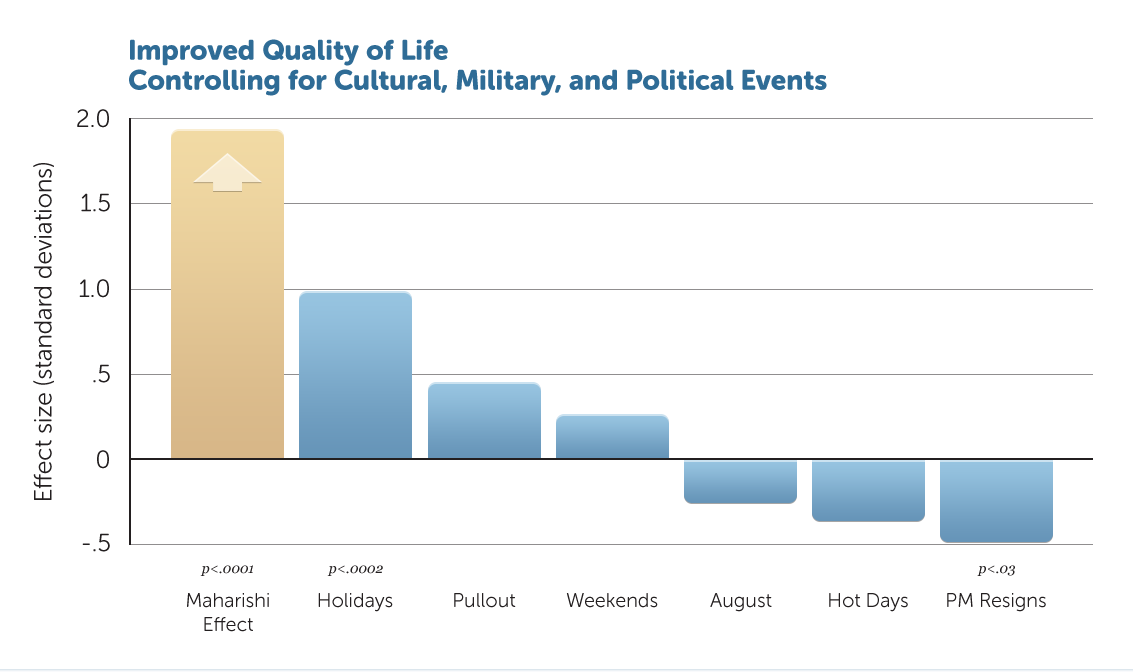 Improved Quality of Life Controlling for Cultural, Military, and Political Events
Improved Quality of Life Controlling for Cultural, Military, and Political Events
This paper reported a follow-up analysis of time series analysis findings previously published in the Journal of Conflict Resolution (1988). The study indicated that during periods in August and September 1983, a significantly large group of TM Sidhi experts in Yogic Flying in Israel produced a significant improvement on multiple indicators of quality of life in Israel, and reduced conflict in Lebanon. The present paper is a response to questions about possible alternative hypotheses in the form of other cultural, military, and political events in Israel and Lebanon during this period. An extensive reanalysis of the original data using time series analysis procedures found that the group practice of the TM and TM Sidhi program continued to be statistically significant in its positive effect on overall quality of life, controlling for all the other hypothesized events. This Maharishi Effect had a stronger influence on the quality of life index than any of the other events (religious holidays, pullout of the Israeli army from Lebanon, weekends, the vacation month of August, hot days (days over the median of maximum daily temperature) and the period following Prime Minister Begin’s resignation).Ref.Journal of Scientific Exploration 23: 193–166, 2009























